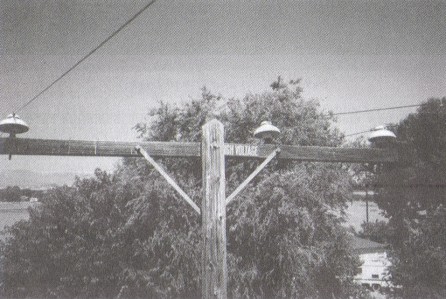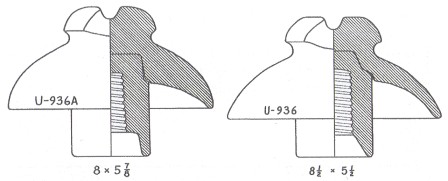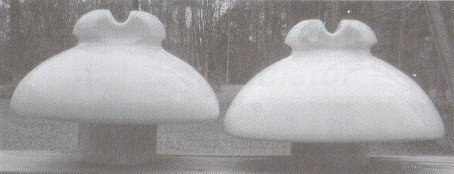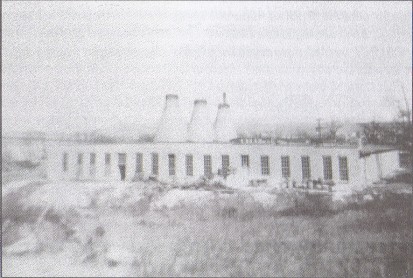Porcelain Insulator News
by Elton Gish
Reprinted from "Crown Jewels of the Wire", March 2002, page 4
Very little was known about U-936 when an unmarked specimen was reported by
Evelyn Anglin in January 1973. Jack Tod was aware of this 2-part glazeweld style
from the 1907 Thomas catalog, but the illustration in the catalog was not
sufficient to make a drawing for the U-Chart. It did not appear in their 1904
catalog and obviously introduced around 1907 with catalog number 2013. All the
other glazeweld styles that were shown in the 1904 catalog were given new
4-digit catalog numbers, too. U-936 could be ordered with either a 1" or
1-3/8" pinhole and it was designed to be used for up to 25,000 volts. The
Anglin insulator had a 1" pinhole, and I believe all the U-936's located so
far also have a 1" pinhole. When we did the survey of about 30 porcelain
collectors for the Value Guide, 8 unmarked U-936's were reported and only one
with an incuse THOMAS marking on the ear. Later it became obvious that these had
been found in the southern California area.
A couple of years ago Mark Johnson
found three U-936's on the same pole in southern California! Two were unmarked
and one had the THOMAS marking on an ear. However, Mark said that one of the
"U-936's" was different. It was in fact a fraction taller and a full 1
/2" smaller in diameter. And the top skirt was much thicker! Mark shipped
the insulator to me for closer inspection (thanks Mark!!) and to make the
drawing for a new U-number. It has been assigned U-936A. It is unmarked but
definitely a 2-part glazeweld made by Thomas. I feel sure U-936A was made after
U-936 because the skirt is so much thicker. Even though U-936A is smaller, it
weighs essentially the same (2-3/8 lbs) as U-936 due to the-thicker skirt. When
U-936 was introduced, thick porcelain was difficult to make. Boch was granted
the 1898 patent for Thomas' "glazefilling" process, which produced
larger insulators by fusing two or more thin shells. Only Imperial had the skill
to make thicker porcelain although it was fraught with large air bubbles. Insulators made
with the glazewelding technique was continued by Thomas in their 1907 catalog,
but soon dropped in favor of using Portland cement to hold shells together.

A photo by Mark Johnson shows the U-936A
still in service. It is in the
middle, and
notice the porcelain high voltage sign.

U-936A (left) and U-936 (right)

U-936A (left) and U-936 (right)
A new manufacturer of pin-type porcelain insulators has been discovered, but
I do not know of any specimens that have been confirmed as having been made by
them. I need your help in identifying specimens that may have been made by
this company. The company is Davidson Porcelain Co. of East Liverpool, OH. I
located one undated catalog for this company and one 1918 catalog for Davidson
& Stevenson Porcelain Co. According to Jack Tod's book, Electrical
Porcelain, the plant was located on the north side of Newell Rd. at Corporation
Line, Newell, WV, but they used an East Liverpool mailing address. East
Liverpool was across the Ohio River and the center for porcelain manufacturing.
Photographs of the factory indicate it was located in Chester, WV, which is a
couple of miles east of Newell.

Abandoned factory of The Davidson Porcelain Company.
The Davidson & Stevenson Porcelain Co. was founded in 1913 (catalog says
1914) to make specialty porcelain (non-pin-types). They leased another pottery
plant at the northeast corner of Broadway and 6th streets in East Liverpool from
1913 to 1919. This plant reverted to Hall China Co. in 1920. When Stevenson left
the company in 1920, the name was changed to The Davidson Porcelain Co. Operations were suspended in 1936. They primarily made specialty porcelain
(knobs, cleats, spools, etc.). Insulators from the earlier operation were
embossed "D & S", "D & S P Co.", "EVER
READY", or "EVER READY / D. P. Co.". The specialty porcelain
insulators would have been made of dry process porcelain.
The 1918 catalog does
show six pin-type insulators for low voltage and distribution service up to
10,000 volts. The illustrations are I an upwardly tilted profile to show the
inner skirt, so a possible unique profile is not obvious. The six styles are
exchange, pony, signal, two cable-tops, and a beehive. There is no indication
that the pin-type insulators were either wet process or dry process. It stands
to reason that if they had been made from wet process, the catalog would have
noted such to make them stand out among the many styles of dry process specialty
porcelain. D & S could be the mystery company who made the dry process U-151 A with unique, often black and tan, shiny glaze. The dimensions and
upwardly tilted profile match exactly! It should be noted, too, that Thomas (a
neighbor to D & S) made several small low voltage styles during this same
time period of dry process porcelain.
The undated catalog of The Davidson
Porcelain Co. (Bulletin No. 131) offered a completely modern array of double and
triple petticoat insulators along with the basic smaller styles. Nowhere in the
catalog does it mention that they were made of wet process porcelain but I am
sure they were. The various triple petticoat styles would not have provided
satisfactory results if they were not wet process. Another indication is a guy
insulator was offered in either wet or dry process, which implies that all other
insulators in the catalog were wet process.
The Davidson "high tension
porcelain" insulators had a very unique and distinctive profile totally
unlike those made by any other manufacturer. Please review the six styles shown
here and see if you have anything similar in your collection. I would like to
identify at least one style so we can begin to identify characteristics that
would help to identify other commonly styled insulators made by D & S.

Davidson claimed their "Balanced Design Insulators...have been styled
not to be different in visual appearance but primarily to provide greater
physical strength." In addition, "The graceful lines of Davidson
Porcelain Insulators have other useful features. They are self-cleaning. Soot
and dust will be washed off with every rain. The lineman has greater freedom in
making ties. There is no likelihood of the cable slapping the porcelain
skirts." They conclude with, "They are manufactured carefully from
only the best raw materials obtainable, and under the supervision of experts for
an important service. They are not cheaper - but better - and last longer."
The unique profiles of these six insulators should make them easy to pick out
from the crowd. Note the straight skirts extending down at a 45-degree angle and
the unusual profile of the smallest cable-top. If Davidson did make these
insulators for several years that closely match the catalog illustrations,
surely some have survived and have found their way into collections. Again, let
me know if you have something close to one of these.
| 